engine coolant SKODA FABIA 2013 2.G / 5J User Guide
[x] Cancel search | Manufacturer: SKODA, Model Year: 2013, Model line: FABIA, Model: SKODA FABIA 2013 2.G / 5JPages: 223, PDF Size: 12.77 MB
Page 125 of 223
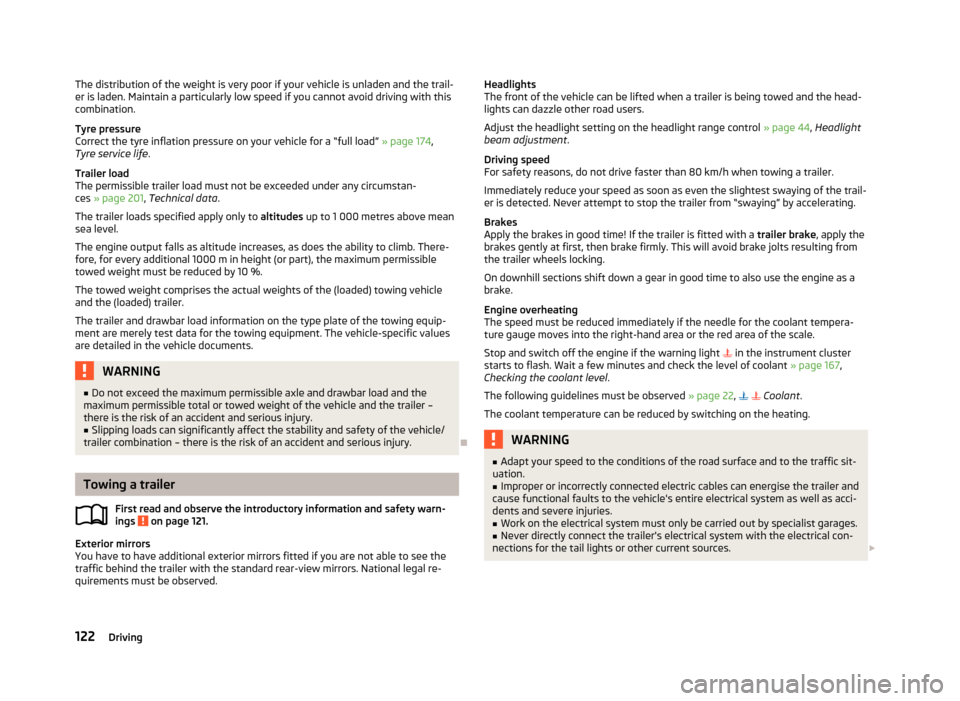
The distribution of the weight is very poor if your vehicle is unladen and the trail-
er is laden. Maintain a particularly low speed if you cannot avoid driving with this
combination.
Tyre pressure
Correct the tyre inflation pressure on your vehicle for a “full load” » page 174,
Tyre service life .
Trailer load
The permissible trailer load must not be exceeded under any circumstan- ces » page 201 , Technical data .
The trailer loads specified apply only to altitudes up to 1 000 metres above mean
sea level.
The engine output falls as altitude increases, as does the ability to climb. There-
fore, for every additional 1000 m in height (or part), the maximum permissible
towed weight must be reduced by 10 %.
The towed weight comprises the actual weights of the (loaded) towing vehicleand the (loaded) trailer.
The trailer and drawbar load information on the type plate of the towing equip- ment are merely test data for the towing equipment. The vehicle-specific values
are detailed in the vehicle documents.WARNING■ Do not exceed the maximum permissible axle and drawbar load and the
maximum permissible total or towed weight of the vehicle and the trailer –
there is the risk of an accident and serious injury.■
Slipping loads can significantly affect the stability and safety of the vehicle/
trailer combination – there is the risk of an accident and serious injury.
Towing a trailer
First read and observe the introductory information and safety warn-
ings
on page 121.
Exterior mirrors
You have to have additional exterior mirrors fitted if you are not able to see the
traffic behind the trailer with the standard rear-view mirrors. National legal re-
quirements must be observed.
Headlights
The front of the vehicle can be lifted when a trailer is being towed and the head-
lights can dazzle other road users.
Adjust the headlight setting on the headlight range control » page 44, Headlight
beam adjustment .
Driving speed
For safety reasons, do not drive faster than 80 km/h when towing a trailer.
Immediately reduce your speed as soon as even the slightest swaying of the trail- er is detected. Never attempt to stop the trailer from “swaying” by accelerating.
Brakes
Apply the brakes in good time! If the trailer is fitted with a trailer brake, apply the
brakes gently at first, then brake firmly. This will avoid brake jolts resulting from
the trailer wheels locking.
On downhill sections shift down a gear in good time to also use the engine as a
brake.
Engine overheating
The speed must be reduced immediately if the needle for the coolant tempera- ture gauge moves into the right-hand area or the red area of the scale.
Stop and switch off the engine if the warning light
in the instrument cluster
starts to flash. Wait a few minutes and check the level of coolant » page 167,
Checking the coolant level .
The following guidelines must be observed » page 22,
Coolant .
The coolant temperature can be reduced by switching on the heating.WARNING■ Adapt your speed to the conditions of the road surface and to the traffic sit-
uation.■
Improper or incorrectly connected electric cables can energise the trailer and
cause functional faults to the vehicle's entire electrical system as well as acci-
dents and severe injuries.
■
Work on the electrical system must only be carried out by specialist garages.
■
Never directly connect the trailer's electrical system with the electrical con-
nections for the tail lights or other current sources.
122Driving
Page 164 of 223
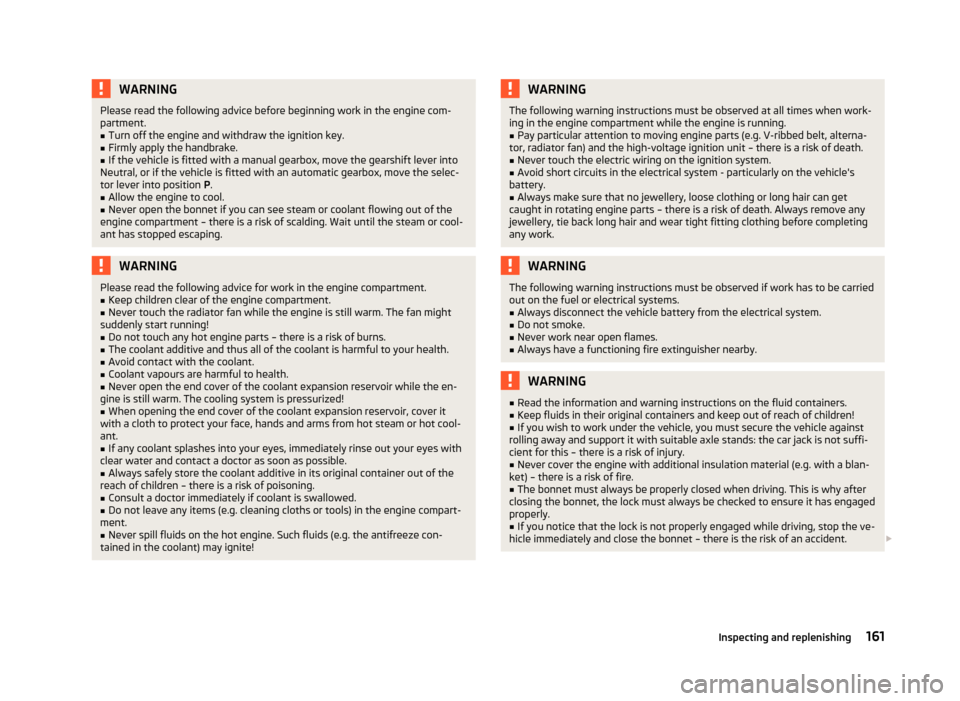
WARNINGPlease read the following advice before beginning work in the engine com-
partment.■
Turn off the engine and withdraw the ignition key.
■
Firmly apply the handbrake.
■
If the vehicle is fitted with a manual gearbox, move the gearshift lever into
Neutral, or if the vehicle is fitted with an automatic gearbox, move the selec-
tor lever into position P.
■
Allow the engine to cool.
■
Never open the bonnet if you can see steam or coolant flowing out of the
engine compartment – there is a risk of scalding. Wait until the steam or cool- ant has stopped escaping.
WARNINGPlease read the following advice for work in the engine compartment.■Keep children clear of the engine compartment.■
Never touch the radiator fan while the engine is still warm. The fan might
suddenly start running!
■
Do not touch any hot engine parts – there is a risk of burns.
■
The coolant additive and thus all of the coolant is harmful to your health.
■
Avoid contact with the coolant.
■
Coolant vapours are harmful to health.
■
Never open the end cover of the coolant expansion reservoir while the en-
gine is still warm. The cooling system is pressurized!
■
When opening the end cover of the coolant expansion reservoir, cover it
with a cloth to protect your face, hands and arms from hot steam or hot cool-
ant.
■
If any coolant splashes into your eyes, immediately rinse out your eyes with
clear water and contact a doctor as soon as possible.
■
Always safely store the coolant additive in its original container out of the
reach of children – there is a risk of poisoning.
■
Consult a doctor immediately if coolant is swallowed.
■
Do not leave any items (e.g. cleaning cloths or tools) in the engine compart-
ment.
■
Never spill fluids on the hot engine. Such fluids (e.g. the antifreeze con-
tained in the coolant) may ignite!
WARNINGThe following warning instructions must be observed at all times when work-
ing in the engine compartment while the engine is running.■
Pay particular attention to moving engine parts (e.g. V-ribbed belt, alterna-
tor, radiator fan) and the high-voltage ignition unit – there is a risk of death.
■
Never touch the electric wiring on the ignition system.
■
Avoid short circuits in the electrical system - particularly on the vehicle's
battery.
■
Always make sure that no jewellery, loose clothing or long hair can get
caught in rotating engine parts – there is a risk of death. Always remove any jewellery, tie back long hair and wear tight fitting clothing before completing
any work.
WARNINGThe following warning instructions must be observed if work has to be carried
out on the fuel or electrical systems.■
Always disconnect the vehicle battery from the electrical system.
■
Do not smoke.
■
Never work near open flames.
■
Always have a functioning fire extinguisher nearby.
WARNING■ Read the information and warning instructions on the fluid containers.■Keep fluids in their original containers and keep out of reach of children!■
If you wish to work under the vehicle, you must secure the vehicle against
rolling away and support it with suitable axle stands: the car jack is not suffi-
cient for this – there is a risk of injury.
■
Never cover the engine with additional insulation material (e.g. with a blan-
ket) – there is a risk of fire.
■
The bonnet must always be properly closed when driving. This is why after
closing the bonnet, the lock must always be checked to ensure it has engaged properly.
■
If you notice that the lock is not properly engaged while driving, stop the ve-
hicle immediately and close the bonnet – there is the risk of an accident.
161Inspecting and replenishing
Page 166 of 223
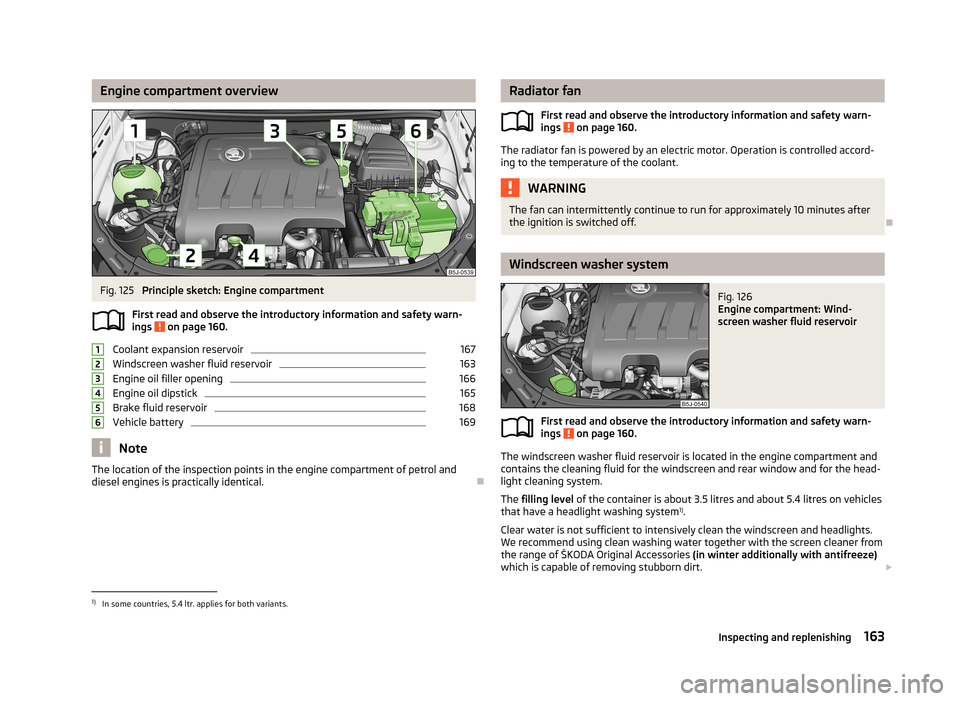
Engine compartment overviewFig. 125
Principle sketch: Engine compartment
First read and observe the introductory information and safety warn- ings
on page 160.
Coolant expansion reservoir
167
Windscreen washer fluid reservoir
163
Engine oil filler opening
166
Engine oil dipstick
165
Brake fluid reservoir
168
Vehicle battery
169
Note
The location of the inspection points in the engine compartment of petrol and
diesel engines is practically identical.
123456Radiator fan
First read and observe the introductory information and safety warn-
ings
on page 160.
The radiator fan is powered by an electric motor. Operation is controlled accord-
ing to the temperature of the coolant.
WARNINGThe fan can intermittently continue to run for approximately 10 minutes after
the ignition is switched off.
Windscreen washer system
Fig. 126
Engine compartment: Wind-
screen washer fluid reservoir
First read and observe the introductory information and safety warn- ings on page 160.
The windscreen washer fluid reservoir is located in the engine compartment and
contains the cleaning fluid for the windscreen and rear window and for the head- light cleaning system.
The filling level of the container is about 3.5 litres and about 5.4 litres on vehicles
that have a headlight washing system 1)
.
Clear water is not sufficient to intensively clean the windscreen and headlights. We recommend using clean washing water together with the screen cleaner from
the range of ŠKODA Original Accessories (in winter additionally with antifreeze)
which is capable of removing stubborn dirt.
1)
In some countries, 5.4 ltr. applies for both variants.
163Inspecting and replenishing
Page 169 of 223
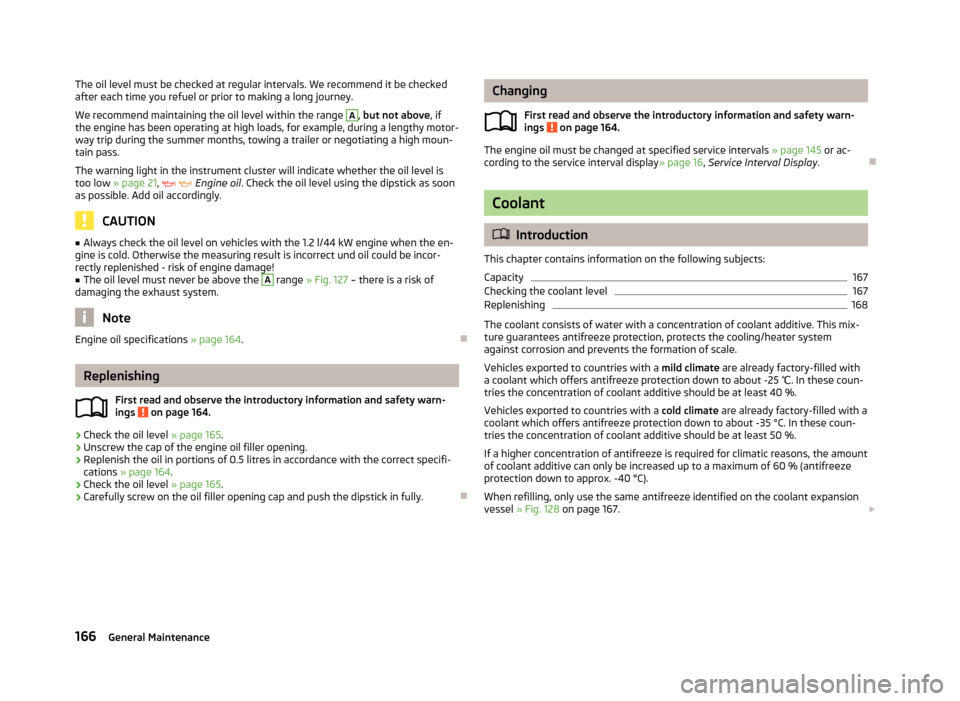
The oil level must be checked at regular intervals. We recommend it be checked
after each time you refuel or prior to making a long journey.
We recommend maintaining the oil level within the range A
, but not above , if
the engine has been operating at high loads, for example, during a lengthy motor-
way trip during the summer months, towing a trailer or negotiating a high moun- tain pass.
The warning light in the instrument cluster will indicate whether the oil level is too low » page 21 , Engine oil . Check the oil level using the dipstick as soon
as possible. Add oil accordingly.
CAUTION
■ Always check the oil level on vehicles with the 1.2 l/44 kW engine when the en-
gine is cold. Otherwise the measuring result is incorrect und oil could be incor-
rectly replenished - risk of engine damage!■
The oil level must never be above the
A
range » Fig. 127 – there is a risk of
damaging the exhaust system.
Note
Engine oil specifications » page 164.
Replenishing
First read and observe the introductory information and safety warn-
ings
on page 164.
›
Check the oil level » page 165.
›
Unscrew the cap of the engine oil filler opening.
›
Replenish the oil in portions of 0.5 litres in accordance with the correct specifi-
cations » page 164 .
›
Check the oil level » page 165.
›
Carefully screw on the oil filler opening cap and push the dipstick in fully.
Changing
First read and observe the introductory information and safety warn-ings
on page 164.
The engine oil must be changed at specified service intervals » page 145 or ac-
cording to the service interval display » page 16, Service Interval Display .
Coolant
Introduction
This chapter contains information on the following subjects:
Capacity
167
Checking the coolant level
167
Replenishing
168
The coolant consists of water with a concentration of coolant additive. This mix-
ture guarantees antifreeze protection, protects the cooling/heater system
against corrosion and prevents the formation of scale.
Vehicles exported to countries with a mild climate are already factory-filled with
a coolant which offers antifreeze protection down to about -25 ℃. In these coun-
tries the concentration of coolant additive should be at least 40 %.
Vehicles exported to countries with a cold climate are already factory-filled with a
coolant which offers antifreeze protection down to about -35 °C. In these coun-
tries the concentration of coolant additive should be at least 50 %.
If a higher concentration of antifreeze is required for climatic reasons, the amount
of coolant additive can only be increased up to a maximum of 60 % (antifreeze
protection down to approx. -40 °C).
When refilling, only use the same antifreeze identified on the coolant expansion vessel » Fig. 128 on page 167.
166General Maintenance
Page 170 of 223
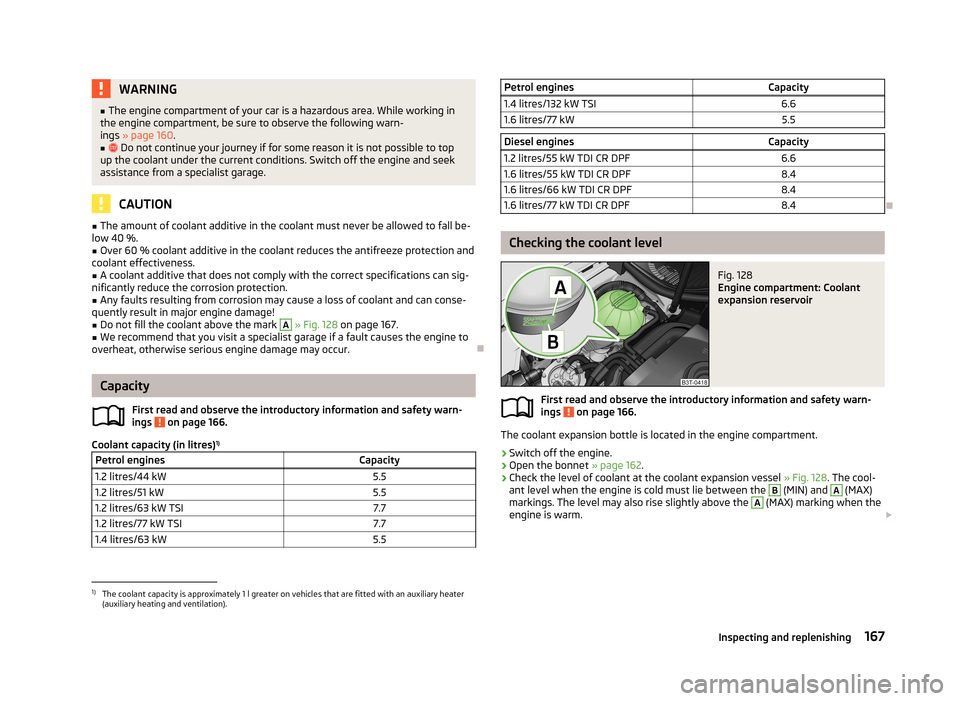
WARNING■The engine compartment of your car is a hazardous area. While working in
the engine compartment, be sure to observe the following warn- ings » page 160 .■
Do not continue your journey if for some reason it is not possible to top
up the coolant under the current conditions. Switch off the engine and seek
assistance from a specialist garage.
CAUTION
■ The amount of coolant additive in the coolant must never be allowed to fall be-
low 40 %.■
Over 60 % coolant additive in the coolant reduces the antifreeze protection and
coolant effectiveness.
■
A coolant additive that does not comply with the correct specifications can sig-
nificantly reduce the corrosion protection.
■
Any faults resulting from corrosion may cause a loss of coolant and can conse-
quently result in major engine damage!
■
Do not fill the coolant above the mark
A
» Fig. 128 on page 167.
■
We recommend that you visit a specialist garage if a fault causes the engine to
overheat, otherwise serious engine damage may occur.
Capacity
First read and observe the introductory information and safety warn-
ings
on page 166.
Coolant capacity (in litres) 1)
Petrol enginesCapacity1.2 litres/44 kW5.51.2 litres/51 kW5.51.2 litres/63 kW TSI7.71.2 litres/77 kW TSI7.71.4 litres/63 kW5.5Petrol enginesCapacity1.4 litres/132 kW TSI6.61.6 litres/77 kW5.5Diesel enginesCapacity1.2 litres/55 kW TDI CR DPF6.61.6 litres/55 kW TDI CR DPF8.41.6 litres/66 kW TDI CR DPF8.41.6 litres/77 kW TDI CR DPF8.4
Checking the coolant level
Fig. 128
Engine compartment: Coolant
expansion reservoir
First read and observe the introductory information and safety warn-
ings on page 166.
The coolant expansion bottle is located in the engine compartment.
›
Switch off the engine.
›
Open the bonnet » page 162
.
›
Check the level of coolant at the coolant expansion vessel » Fig. 128. The cool-
ant level when the engine is cold must lie between the
B
(MIN) and
A
(MAX)
markings. The level may also rise slightly above the
A
(MAX) marking when the
engine is warm.
1)
The coolant capacity is approximately 1 l greater on vehicles that are fitted with an auxiliary heater
(auxiliary heating and ventilation).
167Inspecting and replenishing
Page 171 of 223
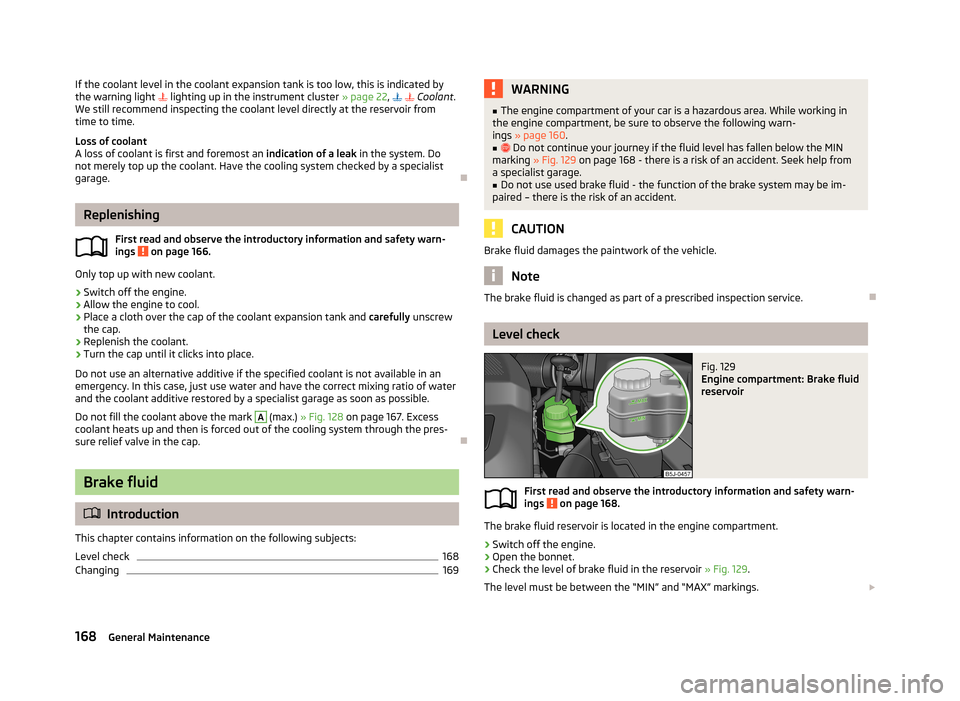
If the coolant level in the coolant expansion tank is too low, this is indicated by
the warning light lighting up in the instrument cluster » page 22, Coolant .
We still recommend inspecting the coolant level directly at the reservoir from
time to time.
Loss of coolant
A loss of coolant is first and foremost an indication of a leak in the system. Do
not merely top up the coolant. Have the cooling system checked by a specialist
garage.
Replenishing
First read and observe the introductory information and safety warn-
ings
on page 166.
Only top up with new coolant.
›
Switch off the engine.
›
Allow the engine to cool.
›
Place a cloth over the cap of the coolant expansion tank and carefully unscrew
the cap.
›
Replenish the coolant.
›
Turn the cap until it clicks into place.
Do not use an alternative additive if the specified coolant is not available in an emergency. In this case, just use water and have the correct mixing ratio of waterand the coolant additive restored by a specialist garage as soon as possible.
Do not fill the coolant above the mark
A
(max.) » Fig. 128 on page 167. Excess
coolant heats up and then is forced out of the cooling system through the pres-
sure relief valve in the cap.
Brake fluid
Introduction
This chapter contains information on the following subjects:
Level check
168
Changing
169WARNING■ The engine compartment of your car is a hazardous area. While working in
the engine compartment, be sure to observe the following warn- ings » page 160 .■
Do not continue your journey if the fluid level has fallen below the MIN
marking » Fig. 129 on page 168 - there is a risk of an accident. Seek help from
a specialist garage.
■
Do not use used brake fluid - the function of the brake system may be im-
paired – there is the risk of an accident.
CAUTION
Brake fluid damages the paintwork of the vehicle.
Note
The brake fluid is changed as part of a prescribed inspection service.
Level check
Fig. 129
Engine compartment: Brake fluid
reservoir
First read and observe the introductory information and safety warn-
ings on page 168.
The brake fluid reservoir is located in the engine compartment.
›
Switch off the engine.
›
Open the bonnet.
›
Check the level of brake fluid in the reservoir » Fig. 129.
The level must be between the “MIN” and “MAX” markings.
168General Maintenance
Page 196 of 223
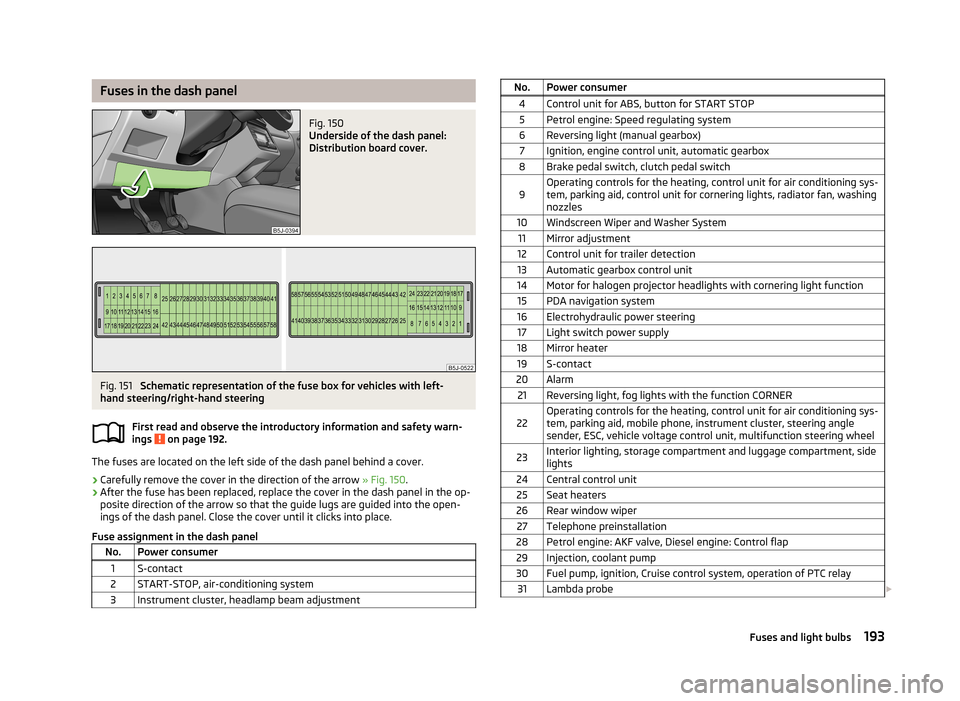
Fuses in the dash panelFig. 150
Underside of the dash panel:
Distribution board cover.
Fig. 151
Schematic representation of the fuse box for vehicles with left-
hand steering/right-hand steering
First read and observe the introductory information and safety warn-
ings
on page 192.
The fuses are located on the left side of the dash panel behind a cover.
› Carefully remove the cover in the direction of the arrow
» Fig. 150.
› After the fuse has been replaced, replace the cover in the dash panel in the op-
posite direction of the arrow so that the guide lugs are guided into the open- ings of the dash panel. Close the cover until it clicks into place.
Fuse assignment in the dash panel
No.Power consumer1S-contact2START-STOP, air-conditioning system3Instrument cluster, headlamp beam adjustmentNo.Power consumer4Control unit for ABS, button for START STOP5Petrol engine: Speed regulating system6Reversing light (manual gearbox)7Ignition, engine control unit, automatic gearbox8Brake pedal switch, clutch pedal switch9Operating controls for the heating, control unit for air conditioning sys-
tem, parking aid, control unit for cornering lights, radiator fan, washing nozzles10Windscreen Wiper and Washer System11Mirror adjustment12Control unit for trailer detection13Automatic gearbox control unit14Motor for halogen projector headlights with cornering light function15PDA navigation system16Electrohydraulic power steering17Light switch power supply18Mirror heater19S-contact20Alarm21Reversing light, fog lights with the function CORNER22Operating controls for the heating, control unit for air conditioning sys-
tem, parking aid, mobile phone, instrument cluster, steering angle
sender, ESC, vehicle voltage control unit, multifunction steering wheel23Interior lighting, storage compartment and luggage compartment, side
lights24Central control unit25Seat heaters26Rear window wiper27Telephone preinstallation28Petrol engine: AKF valve, Diesel engine: Control flap29Injection, coolant pump30Fuel pump, ignition, Cruise control system, operation of PTC relay31Lambda probe 193Fuses and light bulbs
Page 214 of 223
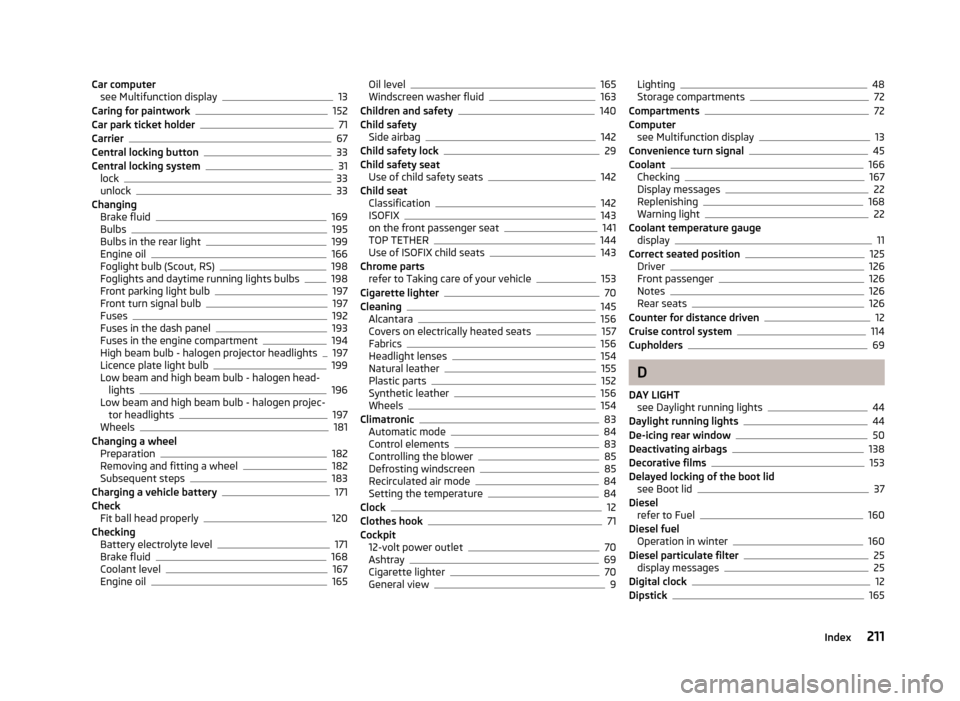
Car computersee Multifunction display13
Caring for paintwork152
Car park ticket holder71
Carrier67
Central locking button33
Central locking system31
lock33
unlock33
Changing Brake fluid
169
Bulbs195
Bulbs in the rear light199
Engine oil166
Foglight bulb (Scout, RS)198
Foglights and daytime running lights bulbs198
Front parking light bulb197
Front turn signal bulb197
Fuses192
Fuses in the dash panel193
Fuses in the engine compartment194
High beam bulb - halogen projector headlights197
Licence plate light bulb199
Low beam and high beam bulb - halogen head-
lights
196
Low beam and high beam bulb - halogen projec-
tor headlights
197
Wheels181
Changing a wheel Preparation
182
Removing and fitting a wheel182
Subsequent steps183
Charging a vehicle battery171
Check Fit ball head properly
120
Checking Battery electrolyte level
171
Brake fluid168
Coolant level167
Engine oil165
Oil level165
Windscreen washer fluid163
Children and safety140
Child safety Side airbag
142
Child safety lock29
Child safety seat Use of child safety seats
142
Child seat Classification
142
ISOFIX143
on the front passenger seat141
TOP TETHER144
Use of ISOFIX child seats143
Chrome parts refer to Taking care of your vehicle
153
Cigarette lighter70
Cleaning145
Alcantara156
Covers on electrically heated seats157
Fabrics156
Headlight lenses154
Natural leather155
Plastic parts152
Synthetic leather156
Wheels154
Climatronic83
Automatic mode84
Control elements83
Controlling the blower85
Defrosting windscreen85
Recirculated air mode84
Setting the temperature84
Clock12
Clothes hook71
Cockpit 12-volt power outlet
70
Ashtray69
Cigarette lighter70
General view9
Lighting48
Storage compartments72
Compartments72
Computer see Multifunction display
13
Convenience turn signal45
Coolant166
Checking167
Display messages22
Replenishing168
Warning light22
Coolant temperature gauge display
11
Correct seated position125
Driver126
Front passenger126
Notes126
Rear seats126
Counter for distance driven12
Cruise control system114
Cupholders69
D
DAY LIGHT see Daylight running lights
44
Daylight running lights44
De-icing rear window50
Deactivating airbags138
Decorative films153
Delayed locking of the boot lid see Boot lid
37
Diesel refer to Fuel
160
Diesel fuel Operation in winter
160
Diesel particulate filter25
display messages25
Digital clock12
Dipstick165
211Index
Page 215 of 223
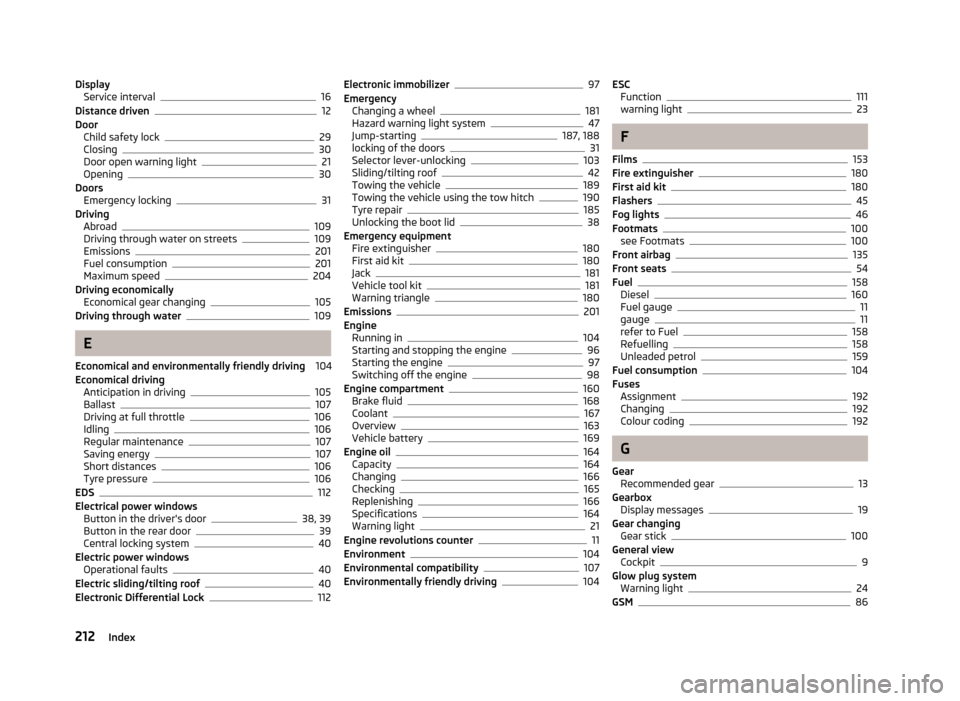
DisplayService interval16
Distance driven12
Door Child safety lock
29
Closing30
Door open warning light21
Opening30
Doors Emergency locking
31
Driving Abroad
109
Driving through water on streets109
Emissions201
Fuel consumption201
Maximum speed204
Driving economically Economical gear changing
105
Driving through water109
E
Economical and environmentally friendly driving 104
Economical driving Anticipation in driving
105
Ballast107
Driving at full throttle106
Idling106
Regular maintenance107
Saving energy107
Short distances106
Tyre pressure106
EDS112
Electrical power windows Button in the driver's door
38, 39
Button in the rear door39
Central locking system40
Electric power windows Operational faults
40
Electric sliding/tilting roof40
Electronic Differential Lock112
Electronic immobilizer97
Emergency Changing a wheel
181
Hazard warning light system47
Jump-starting187, 188
locking of the doors31
Selector lever-unlocking103
Sliding/tilting roof42
Towing the vehicle189
Towing the vehicle using the tow hitch190
Tyre repair185
Unlocking the boot lid38
Emergency equipment Fire extinguisher
180
First aid kit180
Jack181
Vehicle tool kit181
Warning triangle180
Emissions201
Engine Running in
104
Starting and stopping the engine96
Starting the engine97
Switching off the engine98
Engine compartment160
Brake fluid168
Coolant167
Overview163
Vehicle battery169
Engine oil164
Capacity164
Changing166
Checking165
Replenishing166
Specifications164
Warning light21
Engine revolutions counter11
Environment104
Environmental compatibility107
Environmentally friendly driving104
ESC Function111
warning light23
F
Films
153
Fire extinguisher180
First aid kit180
Flashers45
Fog lights46
Footmats100
see Footmats100
Front airbag135
Front seats54
Fuel158
Diesel160
Fuel gauge11
gauge11
refer to Fuel158
Refuelling158
Unleaded petrol159
Fuel consumption104
Fuses Assignment
192
Changing192
Colour coding192
G
Gear Recommended gear
13
Gearbox Display messages
19
Gear changing Gear stick
100
General view Cockpit
9
Glow plug system Warning light
24
GSM86
212Index
Page 217 of 223
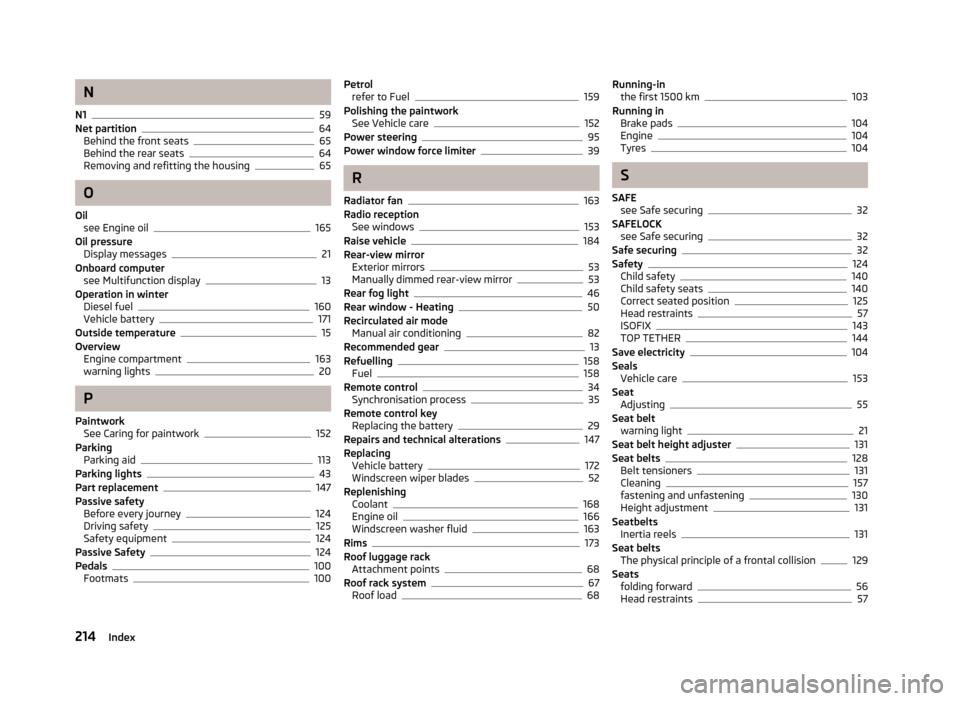
N
N1
59
Net partition64
Behind the front seats65
Behind the rear seats64
Removing and refitting the housing65
O
Oil see Engine oil
165
Oil pressure Display messages
21
Onboard computer see Multifunction display
13
Operation in winter Diesel fuel
160
Vehicle battery171
Outside temperature15
Overview Engine compartment
163
warning lights20
P
Paintwork See Caring for paintwork
152
Parking Parking aid
113
Parking lights43
Part replacement147
Passive safety Before every journey
124
Driving safety125
Safety equipment124
Passive Safety124
Pedals100
Footmats100
Petrol refer to Fuel159
Polishing the paintwork See Vehicle care
152
Power steering95
Power window force limiter39
R
Radiator fan
163
Radio reception See windows
153
Raise vehicle184
Rear-view mirror Exterior mirrors
53
Manually dimmed rear-view mirror53
Rear fog light46
Rear window - Heating50
Recirculated air mode Manual air conditioning
82
Recommended gear13
Refuelling158
Fuel158
Remote control34
Synchronisation process35
Remote control key Replacing the battery
29
Repairs and technical alterations147
Replacing Vehicle battery
172
Windscreen wiper blades52
Replenishing Coolant
168
Engine oil166
Windscreen washer fluid163
Rims173
Roof luggage rack Attachment points
68
Roof rack system67
Roof load68
Running-in the first 1500 km103
Running in Brake pads
104
Engine104
Tyres104
S
SAFE see Safe securing
32
SAFELOCK see Safe securing
32
Safe securing32
Safety124
Child safety140
Child safety seats140
Correct seated position125
Head restraints57
ISOFIX143
TOP TETHER144
Save electricity104
Seals Vehicle care
153
Seat Adjusting
55
Seat belt warning light
21
Seat belt height adjuster131
Seat belts128
Belt tensioners131
Cleaning157
fastening and unfastening130
Height adjustment131
Seatbelts Inertia reels
131
Seat belts The physical principle of a frontal collision
129
Seats folding forward
56
Head restraints57
214Index